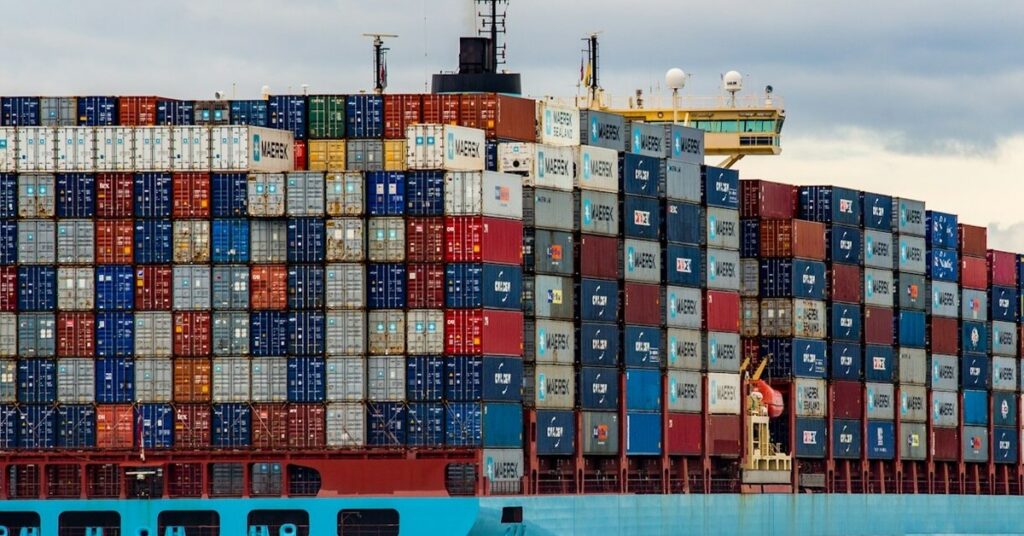What is a TEU? A twenty-foot equivalent unit (TEU) is a widely accepted standard unit of measurement in marine shipping, representing the capacity of a standard 20-foot-long container. This standardization simplifies calculations and communications concerning container ship capacity and cargo capacity, helping shipping companies manage their shipments, voyages and routes more efficiently.
While originally referring to the physical dimension of a 20-foot container, TEU also serves as a unit of measurement for shipping traffic, profit and capacity, playing a key role in tracking port activity levels and optimizing resource allocation strategies in response to changing market demands.

What Is a TEU?
A TEU standard unit for calculating the capacity of container ships and cargo capacity. It’s derived from the standard 20-foot shipping containers, which measure 20 feet in length, 8 feet in width and 8.6 feet in height. Inside the container, it’s 19.4 feet long for loading with 7.8 feet of width and 7.10 feet in height.
The other standard size is FEU, short for a 40-foot equivalent unit. People may also refer to the two as 20-feet or 40-feet general-purpose (GP) containers.
How TEU Is Used as a Unit of Measurement
While TEU is the measurement of one 20-foot container, it can also measure port container traffic. This standard makes it easier to gauge how much is being moved around and how many containers are handled in ports globally.
In 2021, the worldwide number of containers handled in ports was about 851.1 million TEUs, compared to 593.8 million TEUs in 2011. China has the highest number of TEUs with 262 million twenty-foot equivalent units, while the U.S. handles 60.5 million TEUs yearly.
The prestigious Port of Los Angeles remains the U.S.’s leading container hub for 24 straight years, handling 8,630,000 TEUs in 2023. In December 2023, the port processed 747,335 TEUs, a 2.5% YoY growth driven by 5% and 26% increases in loaded imports and exports, respectively. These achievements reflect the port’s tireless pursuit of delivering excellent logistics services and continually meeting rising demands in global maritime commerce.
What are TEUs made of?
Constructed predominantly from high-strength Corten steel, these units exhibit exceptional resistance to adverse weather conditions and corrosive elements.
The primary components of a typical TEU consist of front-end wall panels, a roof, two sidewall panels, a floor and a door frame equipped with a door assembly and locking mechanism. One sidewall panel typically incorporates a modest ventilation opening to facilitate air circulation.
Container security is paramount during transit, especially when transporting valuable commodities. Therefore, regulatory bodies mandate that loaded containers be firmly fastened before departure.
Compliance involves securing the container via lock rods positioned vertically along the double doors, ensuring secure engagement with the designated slots on each door panel. At a minimum, a single approved container seal must be affixed to the lock-rod apparatus, thereby preventing unauthorized entry and safeguarding cargo integrity throughout the journey.
By employing stringent safety measures and adhering to established guidelines, TEU manufacturers and port authorities contribute significantly towards minimizing potential risks associated with containerized shipments, ultimately promoting trust and reliability within the extensive international trade network.
How Did TEU Change Marine Shipping?
TEU standardization improved the efficiency of loading, unloading and transporting containers. Shore-side workers utilize cranes and forklifts to remove containers from ships and place them onto trucks or trains for delivery to their final destinations.
TEUs allow for a straightforward assessment of available storage volume across diverse fleets and facilities. Typically, TEUS can weigh up to 67,200 pounds, though most high-capacity forklifts are designed to lift anything in the 40,000 to 100,000-pound range, allowing for easier offloading. Workers can calculate and communicate the overall capacity of any given marine asset or infrastructure project.
TEUs also play a huge role in tracking port activity levels by offering insights into the aggregate quantity of containers processed annually. Often expressed as throughput, this vital statistic enables decision-makers to monitor fluctuations in demand, optimize resource allocation strategies and enhance operational efficiency within the context of evolving market conditions.
Types of Ships by TEU
Typically, these cargo ships have a container capacity based on their purpose.
Feeder vessels serve an important role in the transportation of containers between ports, acting as “feeders” to larger container ships. They typically have container capacity ranges of approximately 500-1,500 TEUs (twenty-foot equivalent units) and are smaller than other cargo ships.
Handysize cargo ships are another category of smaller vessels capable of entering smaller ports and navigating shallow waterways due to their compact design. Their container capacity ranges from roughly 500-2,000 TEUs, providing flexibility in terms of port accessibility.
One step up in size from handysize vessels are handymax cargo ships. With container capacity ranges spanning about 2,000-4,500 TEUs, these ships offer increased carrying capabilities while maintaining some level of versatility regarding port selection.
Panamax cargo ships are specifically built to fit within the size constraints imposed by the Panama Canal’s locks. This results in smaller dimensions than other ship classes, allowing them to carry around 4,500-6,500 TEUs depending on individual vessel specifications.
Post-Panamax cargo ships provide a solution for those seeking even greater carrying capacity without being limited by the Panama Canal’s dimensions. From approximately 6,500-8,500 TEUs, they offer expanded freight capabilities while retaining maneuverability suitable for many global ports.
At the pinnacle of maritime shipping stands the ultra-large container vessels (ULCVs), boasting impressive container capacities exceeding 10,000 TEUs — sometimes reaching beyond 20,000 TEUs. Designed primarily for long-distance haulage, these colossal ships enable the efficient movement of vast quantities of goods across the world’s oceans.
What Is the Largest Container Ship in the World?
As of 2021, the record for the world’s largest containership is the OOCL Hong Kong, commanding an impressive container capacity of nearly 21,000 TEUs. Launched in 2017 under the auspices of renowned shipping firm OOCL, this formidable vessel stretches beyond 400 meters in length and 60 meters in width, embodying maritime engineering prowess.
However, it is crucial to acknowledge the ever-evolving nature of the container ship sector. Vessel dimensions and capacities possess inherent adaptability over time, rendering the OOCL Hong Kong’s current supremacy subject to eventual supersession. Propelled by continuous advancements in design and technology, the shipping industry consistently pushes boundaries toward expansive and proficient cargo carriers.

History and Development of TEU
Tracing its roots back to the mid-1950s, the TEU emerged as a transformational force disrupting traditional maritime practices. Prior to this paradigm shift, cargo was conventionally stowed aboard vessels within heterogeneous assortments of boxes, crates or barrels, necessitating laborious manual handling procedures upon transferring to land-based transportation modes.
Pioneered by visionary American entrepreneur Malcom McLean, the inaugural intermodal container materialized in 1955, constructed from corrugated steel for effortless transitions between roadgoing trucks and seafaring vessels. Recognizing the potential utility of his innovation, McLean subsequently peddled the concept to the U.S. military, who adopted these standardized units to streamline the transportation of military hardware.
Subsequent years saw a proliferation of diverse container types characterized by idiosyncratic dimensions and securing mechanisms, presenting logistical hurdles when loading onto disparate chassis or decks. However, persistent refinements gradually addressed these issues, culminating in harmonized standards governing both physical attributes and load-securing protocols.
A watershed moment unfolded in 1968 with the christening of Hakone Maru, a trailblazing Japanese-registered vessel conceived explicitly for the conveyance of TEU containers. Boasting a capacity of 752 TEUs, this pioneering ship inaugurated regular services connecting Japan and the western seaboard of the U.S., heralding a new era marked by improved efficiencies, reduced costs and heightened safety across the burgeoning global trade landscape.
Fast forward to contemporary times, where the TEU reigns supreme as the universally acknowledged unit of measure delineating containerized cargo capacities. Spurred by insatiable consumer appetites and accelerated manufacturing output, modern TEU vessels dwarf yesteryear’s comparatively diminutive predecessors, routinely eclipsing 20,000 TEUs or more quotients.
TEU and Reducing Carbon Emissions
When TEU was introduced to the maritime industry, it changed how shipping companies planned their voyages and stored shipments for long journeys. Today, the maritime industry is turning towards the widespread use of larger ships to reduce carbon emissions. Allianz’s 2023 Safety and Shipping report shows that 65% of fleet growth until 2025 will be concentrated on building ships larger than 15,000 TEU. The industry will start seeing fewer fleets smaller than 3,000 TEU to reduce trips and keep supply chains running.
In addition to larger vessels, there must also be a plan to make the ships more efficient, increase safety and reduce pollution. For example, newer designs can reduce fuel consumption by improving efficiency and hydrodynamics. Currently, a large 10,000 TEU capacity ship with a speed of 22 knots would use up to 200 metric tons of fuel per day.
One development in this area is dual-fuel engines. Dual-fuel engines represent a groundbreaking technological achievement within the maritime sector, recognized for their multifaceted capability in energy source management. These sophisticated power plants are ingeniously crafted to function efficiently on two distinct fuel varieties, commonly integrating conventional diesel alongside cleaner alternatives such as liquefied natural gas (LNG).
Such versatility engenders enhanced operational flexibility, enabling ships to transition seamlessly between fuel options in accordance with availability, cost or environmental considerations.
Dual-fuel engines also yield tangible financial advantages by capitalizing on fluctuating market prices of competing energy sources. They propel the industry toward greener horizons, aligning with intensifying emissions legislation by reducing harmful pollutants and carbon footprints.
Consequently, dual-fuel engine adoption garners considerable appeal among environmentally conscious operators striving to balance sustainability objectives with fiscal responsibility amid stringent regulatory pressures.
TEU in Marine Shipping
These simple units hold immense sway over marine shipping operations and broader supply chain dynamics. From their historical emergence to their expanding presence in today’s sprawling logistics networks, TEUs remain a powerful symbol of progress, adaptability and efficiency.
Anticipate ongoing evolution in TEU-related technologies and practices, guided by pressing concerns surrounding climate change, digital transformation and geopolitical shifts. Ultimately, embracing the TEU framework empowers shipping firms and stakeholders alike to confront these challenges head-on, unlocking fresh opportunities for prosperity and growth in the global economy.
Frequently Asked Questions
What is a TEU in relation to marine shipping?
TEU functions as a fundamental measurement in marine shipping, facilitating shipping companies’ planning for shipments, voyages and routes on the supply chain. Since its introduction, TEU has revolutionized the shipping industry by establishing a standard calculation for container and cargo capacity capacity.
How are TEUs used as a unit of measurement?
TEUs measure the capacity of one 20-foot container and evaluate shipping traffic, profit and capacity. They track port activity levels and assist in monitoring fluctuations in demand, making resource allocation and operational efficiency improvements easier.
Which is the Largest TEU?
Until 2021, the largest TEU container ship is the OOCL Hong Kong, with a container capacity of nearly 21,000 TEUs. This imposing vessel, launched in 2017 by the reputed shipping firm OOCL, reaches lengths beyond 400 meters and has a width of 60 meters, exemplifying maritime engineering prowess.
How Much Does a TEU Weigh?
A fully loaded TEU shipping container can weigh up to 67,200 pounds when it’s full. An empty 20-foot container would weigh anything from 3,900-4850 pounds.
Who Invented TEU?
Although TEU itself didn’t have a single inventor, Malcom McLean, an American businessman and entrepreneur, popularized the concept of standardized shipping containers.
- The 15 Most Exciting New Ships of 2025 – January 6, 2025
- How Old Do You Have to Be to Drive a Boat? – November 12, 2024
- The Engineering Behind Ice-Class Vessels – September 20, 2024



